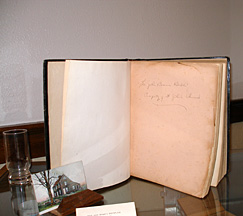resisting slavery
St. John's Congregational Church
Springfield's black population grew rapidly as African-Americans migrated from the South following the Civil War. In 1892, the Sanford Street Church joined with the Quincy Street Mission to form St. John's Congregational Church, so named in honor of John Brown. Dr. William N. DeBerry came to lead St. John's in 1899, and under his leadership the church became nationally-known for its extensive facilities and neighborhood outreach programs.
In 1911, DeBerry organized St. John's Institutional Activities as a social service department which oversaw the establishment of a library, a residence and night classes for women working as domestics, and Camp Atwater, the oldest continuously-run summer camp for African Americans in the United States. St. John’s also ran an employment bureau and helped incoming members of the community find housing.
In 1924, DeBerry separated the social programs division from the church in order to bypass restrictions on the funding of religious programs. He resigned from the pulpit to lead the new organization, reorganized in 1931 as the Dunbar Community League, and the church itself languished for several years. It was reinvigorated in 1945 by the Reverend Albert B. Cleage, who began a program of Inter-racial City Wide Youth Conferences. These programs were continued and expanded by Reverend Charles E. Cobb, who succeeded Cleage in 1951.
During a tumultuous period in Springfield's history, Cobb led the church to the forefront of the regional civil rights movement. Cobb helped to found the United Church of Christ's Commission on Racial Justice (UCCCRJ), bought a bus to ferry students to local colleges, and ran unsuccessfully for mayor on a platform of racial equality. Cobb left St. John's to become director of the UCCCRJ in 1966.
Following Cobb's departure, the church experienced a long period of financial instability until 1997, when the Reverend Howard-John Wesley arrived to transform the church into a prominent and active institution once again. Wesley's ambitious outreach programs increased the size of the congregation from around 200 to almost 3,000 today. Plans are now underway to build a larger church building to accommodate the thriving congregation.
